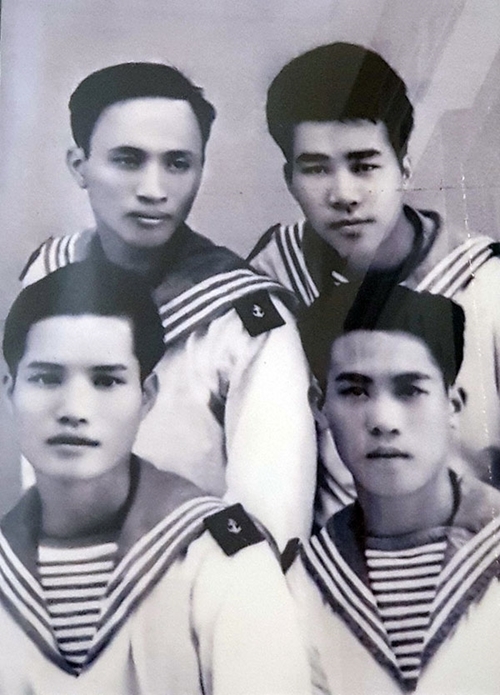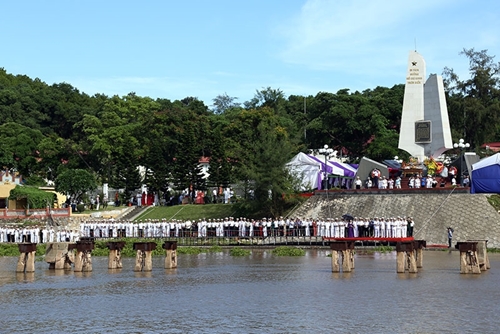Wharf K15 Do Son in Hai Phong was recognized as Km Zero of the Ho Chi Minh trail at sea, where tons of cargo, weapons and equipment were loaded to “no number ships.”
Hard work to build Wharf K15
In 1963, the Central Militay Commission decided to build a wharf in Do Son waters, named K15 to ensure operation of Unit 759 (the precursor of Naval Brigade 125). The General Staff ordered Regiment 83 to do the mission.
Senior Colonel Le Van Xuong, Commanding Officer of the regiment at that time, directedly received the order and sent troops to survey the area.
In February 1963, a group surveyed along Do Son waters and found an appropriate place at Vung Set wharf.
Deputy Chief of the General Staff Le Trong Tan required the regiment’s troops to quickly build Wharf K15 while ensuring technical specifications and absolute safety. He underlined that the wharf will be an important position of the strategic sea trail.
    |
 |
|
Crew-members of a “no-number” ship |
To understand the tidal range, Commander of Le Van Xuong sent two canoes with three men on board to use a rope and a pole to survey the depth. They found and marked a place with the lowest depth of 3 meters at low tide, about 50m off the mainland.
According to the design, the pier is in T-shape, 60m long and 6m wide. Its load-bearing is 10 tons. Duirng the construction, participants had to ensure absolute secrecy.
On April 15, 1963, troops of Battalion 3 of Regiment 83 began the construction. They overcame hardships, worked hard all day and night to complete the pier soon, Commanding Officer of the regiment from 1981-1984 Lieutenant Colonel Le Nhat Cat, recalled.
Thanks to the successful building of Wharf K15 Do Son, Battalion 3 of Regiment 83 was honored with the second-class Feat-of-Arms Order by the State while many of its troops received certificates of merit.
During its 14-year of existance, thousands of troops of the “no-number ships” have been trained, dozens of ships have been built, and hundreds of vehicles have been maintained at factories in Hai Phong.
Rear Admiral Le Ke Lam, former Director of the Naval Academy, held that he had many unforgetable memories when teaching crew-members of “no-number ships” in the city. He told that in late 1962 and at the beginning of 1963, he taught maritime astronomy for 10-sailor groups in a 20sq.m room without knowing anything about them except their names.
    |
 |
|
Wharf K15 is a national level historic site. |
Apart from Wharf K15, the K35 Area Do Son is another training establishment for troops being sent from other military services and corps to Brigade 125.
Senior Colonel Tran Phong, former commander of Unit 759, had conducted many training sessions for sailors of no-number ships.
Meanwhile, veteran Tran Van Lich, a sailor of Ship 41, who joined a training class at K35 said that he had acquired meaningful knowledge from experienced teachers.
In June 1962, Shipyard I was assigned the task of building four new motorized wooden boats in the style of fishing boats of Southern fishermen. After two months of construction, four 30-ton ships were handed over to Unit 759. The ships then transported 112 tons of goods to Region 9.
In October 1962, the Ministry of National Defense signed an agreement with the Ministry of Transport to build six new steel-hulled ships weighing from 50 to 100 tons. Shipyard III conducted this package.
    |
 |
|
Lieutenant Colonel Pham Suu and his comrades recall memories about the no-number ships. |
Military-civilian solidarity strengthened
Troops and people of Hai Phong City wholeheartedly supported sailors of no-number ships.
Lieutenant Colonel Pham Suu, Second-in-Command Officer of Unit 125, who stayed on no-number ships since 1962, never forgot the support of Hai Phong’s authorities and people. He told that although the living conditions were difficulties due to the war, necessities for troops of no-number ships were always ensured adequately.
The people even moved to give their accommodations to naval troops for gathering goods. Local groups and individuals donated not only necessities but also gave their garderns and houses for garrisons.
During its process of building, fighting, and development, the Vietnam People's Navy has always received care from the Party committee, authorities and people of Hai Phong city.
Generations of naval troops will never forget the support of Hai Phong people in the resistance war against foreign invaders and in the protection of the national sovereignty over seas and islands currently.
Translated by Trung Thanh